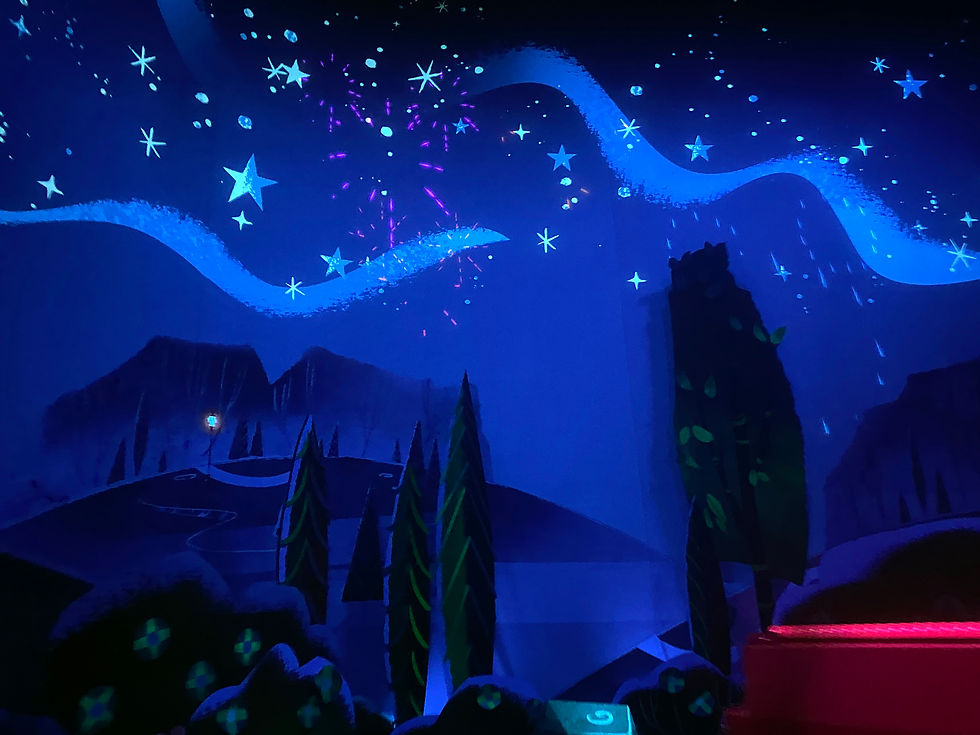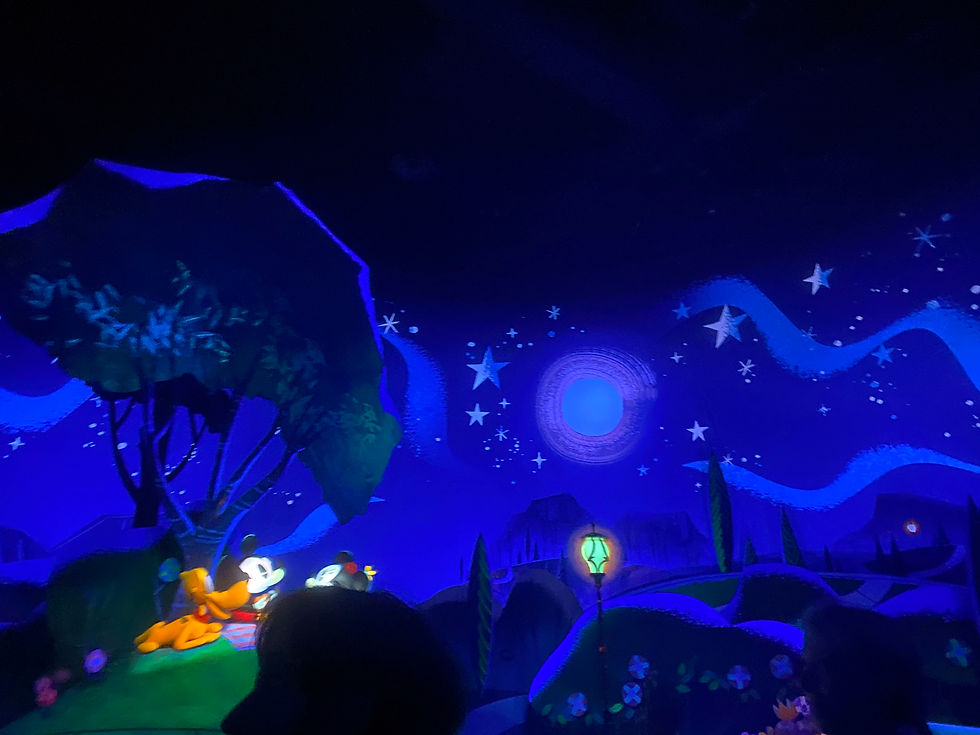Mickey and Minnie's Runaway Railway and Vincent van Gogh's post-impressionist paintings
- Dr. Lauren Kilroy-Ewbank
- Nov 11, 2024
- 5 min read
Updated: Jan 5

If you ever ride Mickey and Minnie’s Runaway railway at Disneyland or at Disney's Hollywood Studies in Orlando, then you’ve undoubtedly been awed by the beautiful ending. Did you know it connects to art history? Hop back on the train, and let's go take a look together.
Mickey and Minnie's Runaway Railway
If you've not had the chance to ride this enchanting (and fun!) attraction, well then let me paint a quick picture—no pun intended. First off, you are going to get a song—"Nothing Can Stop us Now"—stuck in your head for the next year (OK, forever) riding this attraction. Consider it an offering to the Disney House of Mouse.
Nothing can stop us now . . . so let's go!

The premise of the attraction is that Mickey and Minnie are headed out for a picnic. They encounter Goofy, driving a train. One thing leads to another and . . . the train becomes a runaway! Mickey and Minnie drive like they are in some Fast and Furious movie to help us, the dear people on said runaway train, as we pass through different places and scenarios. But the famous mice save the day, and at the end they get their peaceful picnic, just beneath the starry night sky instead of the sun. Luminous swirls abound, stars twinkle, lights burn, and fireworks explode. It's really quite charming and beautiful.
Mickey and Minnie's Runaway Railway and Vincent van Gogh's post-impressionist paintings
The first time I rode this at Disneyland, I got to this moment of the ride and one artist's paintings immediately came to mind: those of everyone’s favorite Post-impressionist Dutch artist Vincent van Gogh. I rode it a few more times, and once at Hollywood Studios, and I've no doubt (!) that Disney artists and animators were influenced by van Gogh. I've said it many times before and will say it again: Disney loves art history.
Let's see if I can convinve you.

Van Gogh’s incredible starry nights fill several of his paintings that he made in southern France in the 19th century. Stars and illuminated lights seem to vibrate in his paintings because of how he handled the paint. The skies swirl. The nost famous of these paintings is, of course, The Starry Night, painted in June 1889 from his room in the asylum of Saint-Rémy. Using his characteristic thick application of paint, known as impasto, van Gogh gives the impression of a glowing moon and stars brightly illuminated in the night sky, with air currents swirling above the towen. Their is a palpable energy, almost an electric current, that syrges through the painting, aided no doubt by the use of blues and yellows.

That same use of blues and yellows, as well as impasto coupled with thick brush strokes, is seen in his Starry Night over the Rhône, painted in 1888 in the city of Arles in southern France. It's another meditation on the lights against the night sky, this time both the lights of the city reflected on the river and the stars twinkling the sky.
Disney Imagineers Adapt Van Gogh
In my art historian opinion, Disney imagineers and artists adapted some of van Gogh's starry nighttime aesthetic for the end scene of Mickey and Minnie's Runaway Railway. It’s REALLY clear in person as you experience it in real time.

Look at those swirls that seem to be both air and light cascade across the sky. Paired with them are different types of twinkling stars. And look! See those tall trees? Those look like cypress trees—which van Gogh was a fan of. If you go back and look at The Starry Night, you will notice a tall one on the left side of the painting.

Even the way the Imagineers and artists provide the glow of the lamp post—it seems to radiate energy in the same way that van Gogh's lights, moon, and stars do—reminds me of the postimpressionist painter. Likewise, the moon in the Disney attraction. It matches several of van Gogh's paitnings.

Like I said above, I think my argument is even more convincing when you are on the ride itself. So, in other words, let’s all go ride it!
There are some other art historical influences at work here too...

Japanese painting and prints
There are other fun artists and artistic traditions that seem to have influenced Disney Imagineers on the ride too—like Japanese prints and Japanese brushwork—which makes sense given Van Gogh was influenced by those things as well. Japonisme, or the European craze for all things Japanese in the 19th century. Artists like van Gogh looked to Edo period Japanese prints, such as those by Hiroshige or Hokusai, for inspiration; he saw new ways to preceive the world and artistic techniques and frameworks that could help him innovate and transform European artistic traditions. Likewise, other types of Japanese objects flooded into Europe, including diferent types of painting.

I mention this because there is a certain calligraphic sense to the leaves that look like they have been inked onto the trees in this picnic scene. If you look at the tree behind and above Mickey and Minnie, you will notice what look like horiztonal cut marks on the tree's trunk. Then, in the foliage, there are triangular tapered leaves that looked stamped onto a darker background. It reminds me so much of Japanese paintings of bamboo and even sumi-e, or black ink painting.
If you look at the painting attributed to Katsushika Hokusai of bamboo that I've included here, notice the horizontal strokes of the bamboo and the way the leaves are painted. Then, look again at the Runaway Railway tree. Do you see the same visual connection that I do?
I'd be remiss not to note that painting bamboo in this way (or sumi-e) was not solely a Japanese phenomenon, but you also see it earlier in Chinese painting as well. Just like the craze for Japanese goods, there was a similar interest in Chinese goods during van Gogh's time. All of these together add to the general van Gogh-ness of that end scene in the Disney attraction.
Nothing can stop me now...
There is still much that I can unpack visually about what I see in this Disney attraction—so many art history layers!—but for now I will end this post. What do you think? Have I convinced you that the artists and Imagineers were looking to van Gogh and the Japanese objects influencing van Gogh and his contemporaries?
Let me know!
And if you've enjoyed this post about Mickey and Minnie's Runaway Railway and Vincent van Gogh's post-impressionist paintings, please sign up for my newsletter where you will find more Disney art history and general nerdiness.
Learn more!
If you are interested in learning more about Japonisme, check out this short essay from the Heilbrunn Timeline.
There is a lot to learn about post-impressionism, but here is a nice place to start from the Heilbrunn Timeline.
Comments